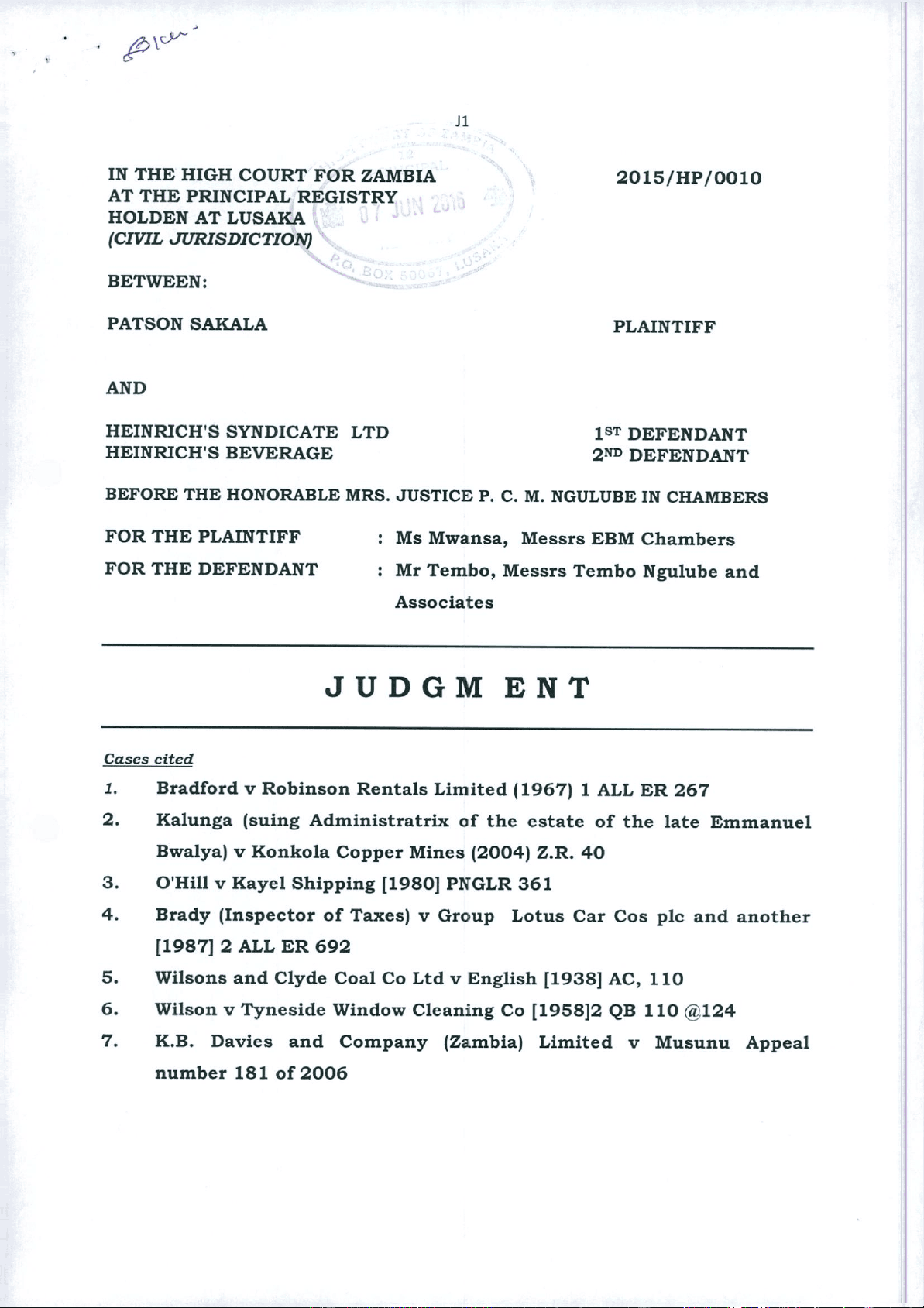
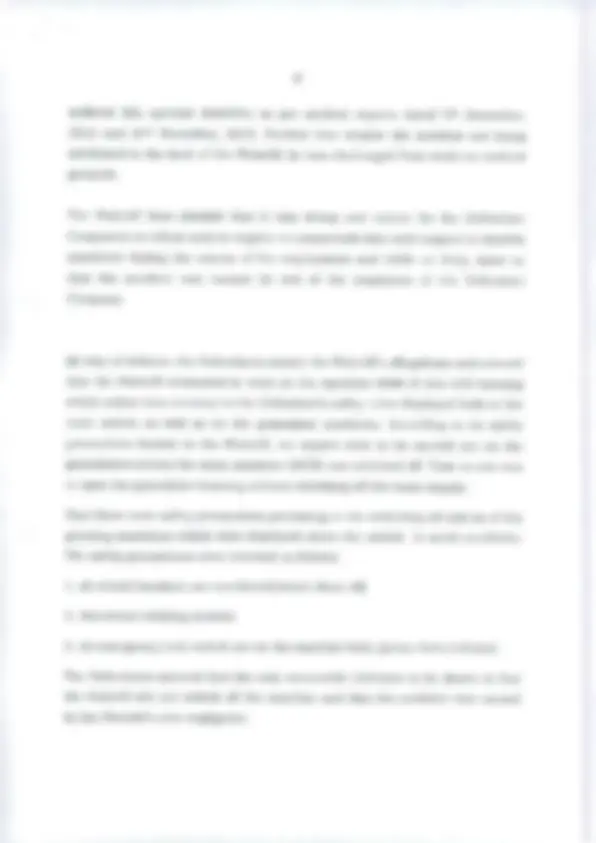
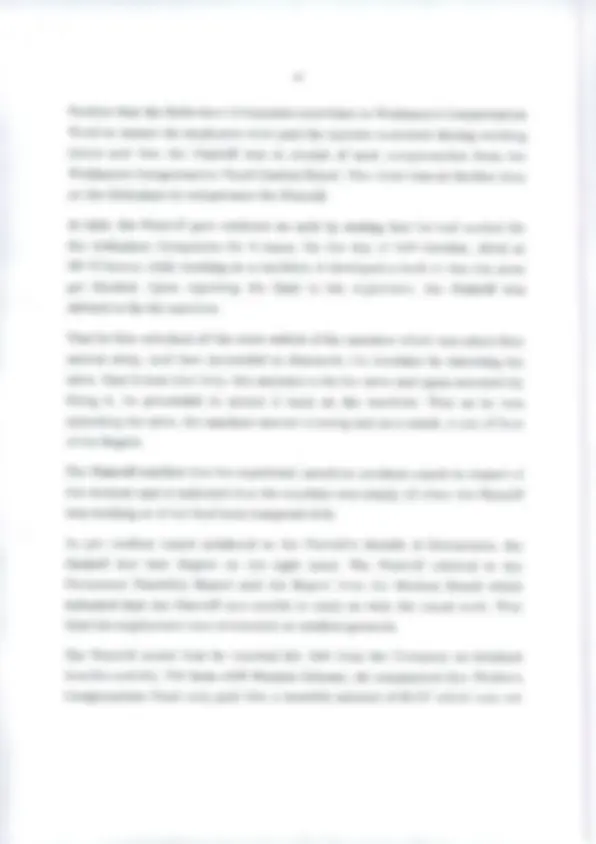
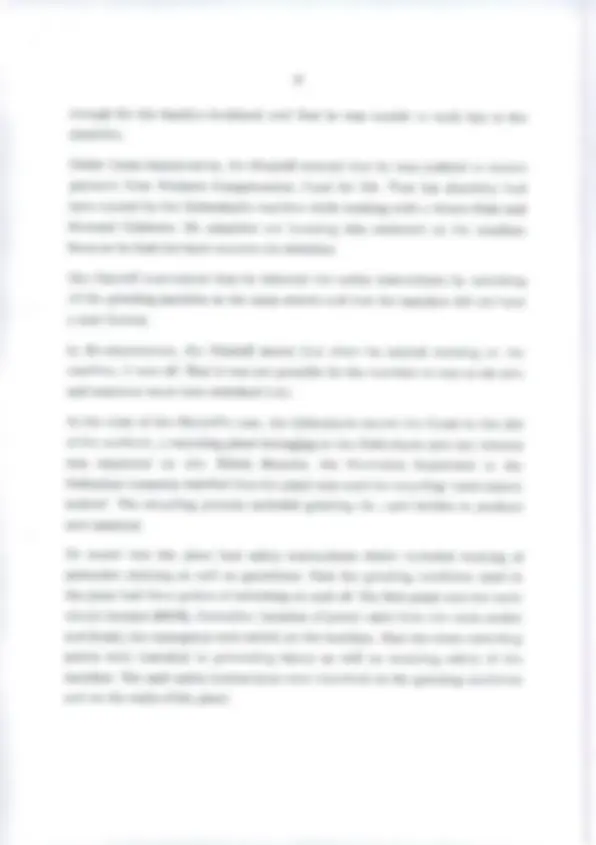
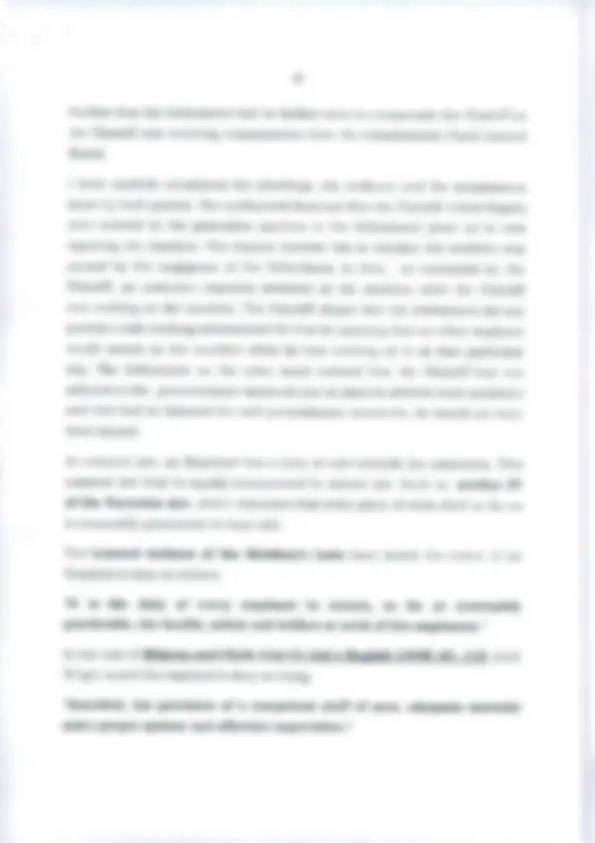
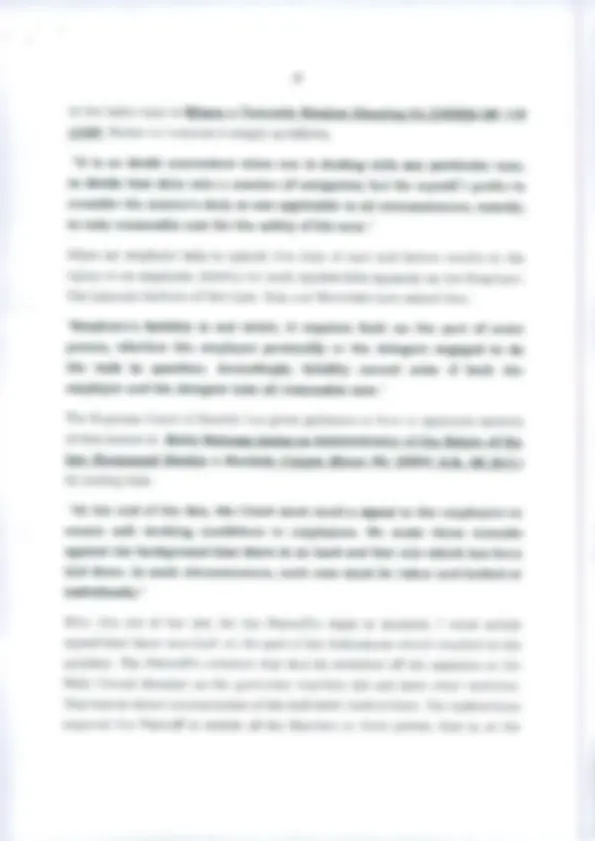
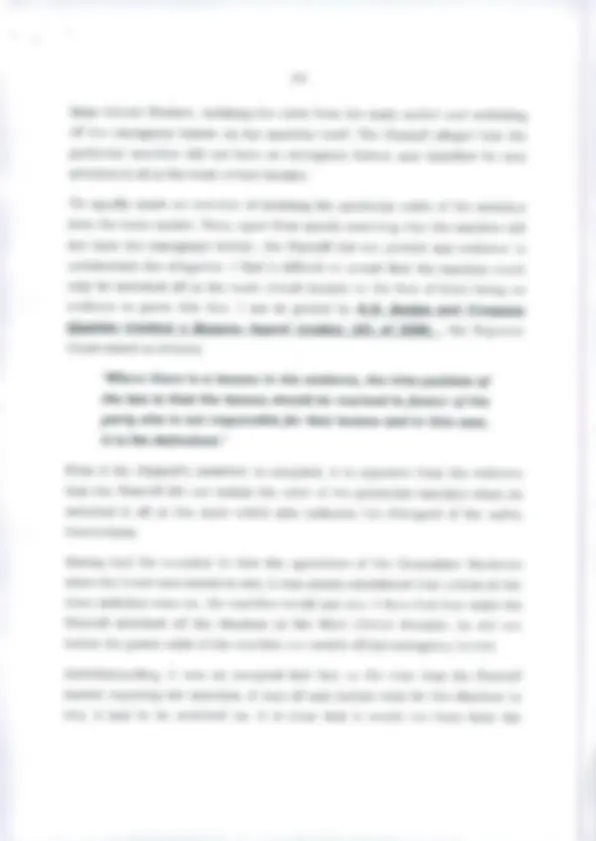


Study with the several resources on Docsity

Earn points by helping other students or get them with a premium plan


Prepare for your exams
Study with the several resources on Docsity

Earn points to download
Earn points by helping other students or get them with a premium plan
Community
Ask the community for help and clear up your study doubts
Discover the best universities in your country according to Docsity users
Free resources
Download our free guides on studying techniques, anxiety management strategies, and thesis advice from Docsity tutors
A court case in which a plaintiff, who lost four fingers in a factory accident, sued the defendants for failing to provide a safe working environment. The dispute centered around whether the defendants were responsible for an unknown employee switching on the machine while the plaintiff was working on it. evidence from both parties, legal arguments, and the judge's final decision.
Typology: Schemes and Mind Maps
1 / 11

This page cannot be seen from the preview
Don't miss anything!







IN THE HIGH COURT FOR ZAMBIA AT THE PRINCIPAL REGISTRY HOLDEN AT LUSAKA (CIVIL JURISDICTION) BETWEEN: PATSON SAKALA
AND HEINRICH'S SYNDICATE LTD HEINRICH'S BEVERAGE
11
2015/HP/001O
PLAINTIFF
1 ST DEFENDANT 2 ND^ DEFENDANT BEFORE THE HONORABLEMRS. JUSTICE P. C. M. NGULUBEIN CHAMBERS FOR THE PLAINTIFF FOR THE DEFENDANT
Cases cited
Ms Mwansa, Messrs EBM Chambers Mr Tembo, Messrs Tembo Ngulube and Associates
Legislation cited
1. The Factories Act, Chapter 441 of the Laws OF Zambia Other Materials referred to: 1. Halsbury's Laws of England, 4 th^ **Edition
The Plaintiff commenced this matter by way of Writ of Summons claiming the followingreliefs;
In the accompanying Statement of Claim, the Plaintiff averred that on 12th October, 2012 while he was in the employ of the Defendant Companies as a machine operator, he experienced a fault with one of the grinding machines. On checking the machine, he discovered that the machine had been blocked by a mesh. He thus proceeded to switch off the grinding machine so as to fix it.
That as he was fixing the machine, the machine rota started running, as a result, his right hand which was inside the machine sustained injuries and four of his fingers were amputated.
The Plaintiff alleged that the Machine was switched on by one of the Defendants' employees who he could not identify as the switch for the machine was almost three metres away. As a consequence of the accident, the Plaintiff
Further that the Defendant Companies contribute to Workmen's Compensation Fund to ensure its employees were paid for injuries sustained during working hours and that the Plaintiff was in receipt of such compensation from the Workmen's Compensation Fund Control Board. That there was no further duty on the Defendant to compensate the Plaintiff.
At trial, the Plaintiff gave evidence on oath by stating that he had worked for the Defendant Companies for 4 years. On the day of 12th^ October, 2012 at 08 45 hours, while working on a machine, it developed a fault in that the sieve got blocked. Upon reporting the fault to his supervisor, the Plaintiff was advised to fIx the machine.
That he fIrst switched off the main switch of the machine which was about four metres away, and then proceeded to dismantle the machine by removing the sieve. That it took him forty- fIve minutes to fIx the sieve and upon successfully fIxing it, he proceeded to mount it back on the machine. That as he was mounting the sieve, the machine started running and as a result, it cut off four of his fIngers.
The Plaintiff testifIed that his supervisor :ssued an accident report in respect of the incident and it indicated that the machine was totally off when the Plaintiff was working on it but had been tampered with.
As per medical report produced in the Plaintiffs Bundle of Documents, the Plaintiff lost four fIngers on his right hand. The Plaintiff referred to the Permanent Disability Report and the Report from the Medical Board which indicated that the Plaintiff was unable to carryon with the usual work. That thus his employment was terminated on medical grounds.
The Plaintiff stated that he received K3, 000 from the Company as terminal benefIts and K2, 700 from AON Pension Scheme. He complained that Workers Compensation Fund only paid him a monthly amount of K137 which was not
enough for his family's livelihood and that he was unable to work due to his disability.
Under Cross Examination, the Plaintiff averred that he was entitled to receive payment from Workers Compensation ?und for life. That his disability had been caused by the Defendant's machine while working with a Moses Phiri and Bernard Chikwete. He admitted not knowing who switched on the machine because he had his back towards the switches.
The Plaintiff maintained that he followed the safety instructions by switching off the grinding machine at the main switch and that the machine did not have a start button.
In Re-examination, the Plaintiff stated that when he started working on the machine, it was off. That it was not possible for the machine to run on its own and someone must have switched it on.
At the close of the Plaintiffs case, the Defendants moved the Court to the site of the accident, a recycling plant belonging to the Defendants and one witness was examined on site. Edwin Nyambe, the Protection Supervisor in the Defendant company testified that the plant was used for recycling "used maheu bottles". The recycling process included grinding the used bottles to produce new material.
He stated that the plant had safety instructions which included wearing of protective clothing as well as guidelines. That the grinding machines used in the plant had three points of switching or. and off. The first point was the main circuit breaker (MCB),thereafter, isolation of power cable from the main socket and finally the emergency unit switch on the machine. That the three switching points were essential in preventing inju:-y as well as ensuring safety of the machine. The said safety instructions were inscribed on the grinding machines and on the walls of the plant.
employees would cause injury to the Plaintiff by turning on the machine while the Plaintiff was working on it.
Relying on Kalunga (suing Administratrix of the estate of the late Emmanuel Bwalyal v Konkola Copper Mines (2004) Z.R. 40, it was submitted that the defence of volenti non fit injuria was not available to the Defendant.
Further relying on the case of O'Hill v Kayel Shipping [1980] PNGLR 361 and section 10 (1) of the Law Reform (Miscellaneous Provisions) Act Chapter 74 of the Laws of Zambia, it was submitted that to successfully plead the defence of contributory negligence, the employer had the onus of satisfying the Court that the employee was negligent in the sense that he acted in a manner so unreasonable as to put himself in the domain of the injury which was foreseeable to him and actually suffered.
The Plaintiff submitted in sum that the facts presented a. case of breach of common law duty to provide a safe system of work and that the Plaintiff had proved his case on a balance of probabilities.
In response, the Defendant submitted that there were set parameters in the common law duty of care and that to be successful, the Plaintiff must prove on a balance of probabilities, that the breach of duty caused, or materially contributed to, his injury.
It was contended that the Plaintiff did not adhere to the safety precautions set by the employers and therefore, the accident was caused by his own negligence.
Relying on Brady (Inspector of Taxes) v Group Lotus Car Cos pIc and another [1987] 2 ALL ER 692, it was submitted that the Plaintiff lamentably failed to discharge the burden of proof i:1 relation to the allegations that the emergency button was placed after the accident happened and that some "mystical person" must have switched on the Grinding Machine.
Further that the Defendants had no further duty to compensate the Plaintiff as the Plaintiff was receiving compensation from the compensation Fund Control Board.
I have carefully considered the pleadings, the evidence and the submissions made by both parties. The undisputed facts are that the Plaintiff's four fingers were severed by the granulator machine in the Defendants' plant as he was repairing the machine. The dispute however lies in whether the accident was caused by the negligence of the Defendants, in that, as contended by the Plaintiff, an unknown employee switched on the machine while the Plaintiff was working on the machine. The Plaintiff alleges that the Defendants did not provide a safe working environment for h:m by ensuring that no other employee would switch on the machine while he was working on it on that particular day. The Defendants on the other han:! contend that the Plaintiff had not adhered to the precautionary measures put in place to prevent such accidents and that had he followed the said precautionary measures, he would not have been injured.
At common law, an Employer has a duty of care towards his employees. This common law duty is equally incorporated in statute law. Such as section 37 of the Factories Act, which stipulates that every place of work shall so far as is reasonably practicable be kept safe. The Learned Authors of the Halsbury's Laws have stated the extent of an Employer's duty as follows;
"It is the duty of every employer to ensure, so far as reasonably practicable, the health, safety and welfare at work of his employees."
In the case of Wilsons and Clyde Coal Co Ltd v English [19381 AC, 110, Lord Wright stated the employer's duty as being,
"threefold, the provision of a competent staff of men, adequate material and a proper system and effective supervision."
110
Main Circuit Breaker, isolating the cable from the main socket and switching off the emergency button on the machine itself. The Plaintiff alleged that the particular machine did not have an en:ergency button and therefore he only switched it off at the main circuit breaker.
He equally made no mention of isolating the particular cable of the machine from the main socket. Thus, apart from merely asserting that the machine did not have the emergency button, the Plaintiff did not provide any evidence to substantiate the allegation. I find it difficult to accept that the machine could only be switched off at the main circuit breaker in the face of there being no evidence to prove this fact. I am so guided by K.B. Davies and Company (Zambia) Limited v Musunu Appeal number 181 of 2006 , the Supreme Court stated as follows;
"Where there is a lacuna in the evidence, the trite position of the law is that the lacuna should be resolved in favour of the party who is not responsible for that lacuna and in this case, it is the defendant."
Even if the Plaintiffs assertion is accepted, it is apparent from the evidence that the Plaintiff did not isolate the cable of the particular machine when he switched it off at the main which also indicates his disregard of the safety Instructions.
Having had the occasion to view the operations of the Granulator Machines when the Court was moved to site, it was clearly established that unless all the three switches were on, the machine would not run. I thus find that while the Plaintiff switched off the Machine at the Main Circuit Breaker, he did not isolate the power cable of the machine nor switch off the emergency button.
Notwithstanding, it was an accepted fact that at the time that the Plaintiff started repairing the machine, it was off and further that for the Machine to run, it had to be switched on. It is clear that it would not have been the
Plaintiff as he was positioned 3 metres away from the Main Circuit Breaker. The Accident Reports produced in both the Plaintiffs and the Defendants' bundles indicate that the findings revealed that an unknown employee had switched on the machine while the Plaintiff was trying to fix the sieve.
This in my view does not aid the Plaintiffs case for the simple reason that had the machine been switched off at all the three points, the intervening act of an unknown employee of switching on the machine at one point would not have resulted in the machine running. The Plaintiff appears to be at the centre of his misfortune by his failure to follow the laid down guidelines of switching off the machine at all the three points.
Therefore, on the totality of the evidence, I do not see any fault on the part of the Defendants nor that the Defendants failed to uphold their duty of care towards the Plaintiff which ultimately resulted in the accident.
Based on the foregoing, the Plaintiffs case fails and costs to the Defendants to be taxed in default of agreement.
Dated this 7th^ June, 2016
P. C. M. NGULUBE HIGH COURT JUDGE